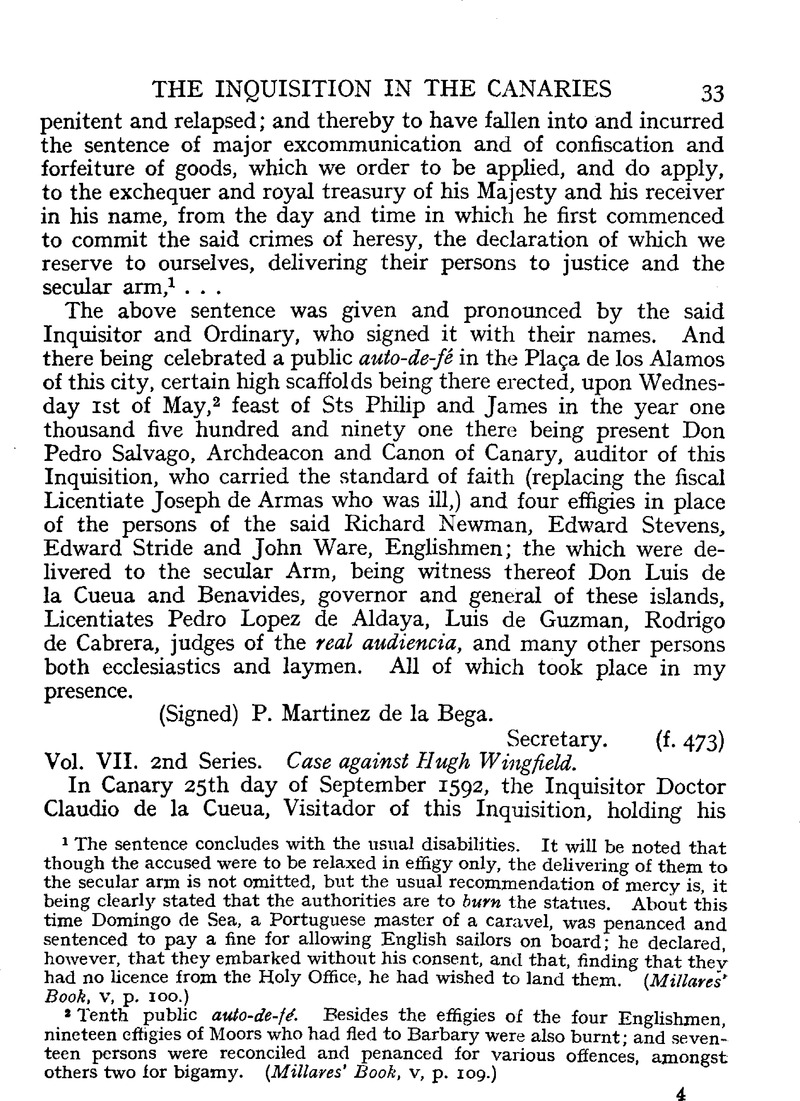No CrossRef data available.
Article contents
Case against Hugh Wingfield
Published online by Cambridge University Press: 24 December 2009
Abstract

- Type
- The Inquisition in the Canaries: I. English Text
- Information
- Copyright
- Copyright © Royal Historical Society 1912
References
page 33 note 1 The sentence concludes with the usual disabilities. It will be noted that though the accused were to be relaxed in effigy only, the delivering of them to the secular arm is not omitted, but the usual recommendation of mercy is, it being clearly stated that the authorities are to burn the statues. About this time Domingo de Sea, a Portuguese master of a caravel, was penanced and sentenced to pay a fine for allowing English sailors on board; he declared, however, that they embarked without his consent, and that, finding that they had no licence from the Holy Office, he had wished to land them. (Millare's Book, v, p. 100.)
page 33 note 2 Tenth public auto-de-fé Besides the effigies of the four Englishmen, nineteen effigies of Moors who had fled to Barbary were also burnt; and seventeen persons were reconciled and penanced for various offences, amongst others two for bigamy. (Millares' Book, v, p. 109.)
page 34 note 1 See Appendix C.
page 36 note 1 See Appendix D.
page 40 note 1 The evidence given by this witness, as also by Nicholas Christopher and Juan Giraldo, is similar to that supplied by Hans Anburque. A warrant was then issued for the arrest with sequestration of their property of Francis Lewis of Bristol, aged 20; Constantine Colling of Tavistock, near Exeter (Tavistod en la provincia de Exister); Robert Estrefi, over 16 of Hever in Kent (Hevera en Quende); Richard Percy, 25 or 26 of Drayton, fourteen leagues from London; and William Sebastian, 22, of Scarborough (Scarbar). All of whom gave evidence against Wingfield. Their statements and the accounts of their lives are of no particular interest. Colling stated that he was for some time in the service of an English captain, William Axley (Axli), who, with a small vessel and a crew of about fourteen men, sailed the English Channel for the purpose of piracy. In about thirteen weeks they seized four vessels—three English and one Irish—his share of the plunder amounting to 600 reales. After the evidence of these men was taken a warrant was issued for the transmission of the accused man Wingfield from Teneriffe to Canary.
page 43 note 1 In order to crush Lutheranism at its birth, Cardinal Manrique, Inquisitor General from 1523 to 1538, made various additions to the annual edict of Faith, which were calculated to assist the faithful in detecting Lutherans; such as, whether anyone was known to have said that confession was unnecessary, that neither Pope nor priests had power to forgive sins, that priests, monks and nuns should marry, that matrimony was a more perfect state than that of the clergy, celibates, and so on.
page 52 note 1 Though Wingfield escaped the other five Englishmen appeared in the auto of December 21, 1597. (See Note p. 80.)
page 52 note 2 Similar instructions were issued by the Suprema to the tribunals in 1597, in favour of the ships of the Hansa. (Lea, vol. III, p. 463.)




